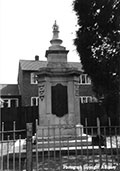Private Harold Nelson, 1939
- Batt - 1/5
- Unit - Leicestershire Regiment
- Section -
- Date of Birth - 15/06/1884
- Died - 25/09/1915
- Age -
Add to this record?
If you have photographs, documents or information that can contribute to this record, you can upload here
ContributeSource: Michael Doyle Their Name Liveth For Evermore: The Great War Roll of Honour for Leicestershire and Rutland. The War Diary for today Records. TRENCHES. At 3.50am bombardment of HOOGE. Enemy replied and also shelled A1. and 50. At 5.56am Straw which had been put out by night was lighted in front of 50. Smoke bombs were thrown from 49. and A1. This promptly drew fire. 50. and A1. were heavily shelled and 49. trench mortared. Artillery telephone communication lost but 3rd LINCOLNSHIRE Battery and 2nd DERBYSHIRE Howitzer fired over 50. and 49. and later 4th STAFFORDSHIRE Battery. About 7.l5am bombardment ended and the rest of the day was fairly quiet.
Source: Leicestershire War Memorials Project. Harold Nelson was born on the 15th June 1884, the firstborn child to parents George Nelson and Mary Ann Roberts. His brother George Harry Nelson (1885-1952) served with the Warwickshire Regiment during WW1: other siblings , Ethel, Percy Frederick and Gladys, died in infancy.
In 1901, Harold is recorded as living at The Lant, Shepshed and his occupation is given as a Shoe Plater. In 1911, at the age of 26, Harold was still living at home in Shepshed with his parents, and worked in the hosiery industry.
Harold joined the military in 1914, aged 30, and died on the 25th September, 1915, in West Flanders.
The following account of his death was submitted by J. Nelson, Great Grandson of George Harry Nelson- and is extracted from 'Soldiers of Shepshed Remembered 1914-1919' by Russell Fisher.
The 1/5th Leicestershire Battalion would not participate in the main assault at Loos, but instead found themselves assigned to a diversionary operation near Hooge, where the 3rd and 14th Divisions were scheduled to attack in an effort to draw off the German reserves from Loos. For their part in the proceedings, the Shepshed men set about pitching large piles of damp straw along their barbed wire under cover of darkness.
Shortly before 4am on the 25th September, the British artillery opened up at Hooge, the towers of Ypres intermittently illuminated by the numerous flashes from steel muzzles that spat their destructive loads into the quivering air. Just before 6am, the order came to light the straw and soon thick palls of smoke billowed into no-man's land. To the German observers, it seemed that the British were launching a gas attack and their artillery quickly directed its fire onto the trenches held by the 1/5th Leicestershire Battalion, in the hope of hitting the troops who might have been assembled to follow the gas cloud. Terrified by the prospect of facing a gas attack, the Germans hastily evacuated their trenches, and within half an hour, their own artillery began bombing the deserted trenches on the northern slopes of Hill 60, assuming that they had fallen to the British. The ruse was a complete success, except that no attempt at exploitation was forthcoming. The Leicesters' orders were, quite simply to stay put.
The veneer of success was disappointingly short-lived, exacerbated by the fact that the battalions adjacent to the Leicesters' had failed to ignite their straw due to an unfavourable wind. The German artillery observers then focussed their gunners attention on the source of the 'gas' that portion of the front line held by the 1/5th Leicestershire Battalion. Scores of shells arced across no-man's land, and C Company in the centre of the Leicesters' line took the full force of this vengeful fire. Adjutant J D Hills recorded the terrifying scene:
Choked and blined by the smoke from the straw, which blew back and filled the trench, their parapet blown away by salvo after salvo of small shells, their supports battered with 8 inch and heavy mortars, with no cover against the unceasing rain of shells from front and left, they had to bear it all in silence, unable to hit back.
At 7:15am, the bombardment ceased, allowing stretcher bearers to evacuate the wounded while the dazed survivors cleared away piles of smouldering straw blown by shell bursts into the bottom of the trenches. Among the casualties lay the lifeless figure of 31 Harold Nelson, a former employee at Moss and Sons' hosiery Factory in Loughborough. Harold had joined the Territorials on the 9th June 1914, and had sailed for France with a draft of reinforcements on the 20th June 1915.
On the 29th January 1916, a small parcel arrived at the home of Harold's parents, George and Mary Ann Nelson of Hall Croft. Inside the wrapping was the small bible given to Harold by the congregation of the Baptist church on Charnwood Road prior to his departure for France, which he had always carried with him. Ultimately, it proved to be the only physical memento of his death, since his grave, like so many others in the Ypres Salient, was lost during the war.'
- Conflict - World War I
- Birth Place - Shepshed
- Other Memorials - Shepshed Oaks & Charley
- Unit - Leicestershire Regiment
- Cause of death - KILLED IN ACTION
- Burial Commemoration - Ypres (Menin Gate) Mem., West Vlaanderen, Belgium
- Born - Shepshed, Leicestershire
- Enlisted - Shepshed, Leicestershire
- Memorial - SHEPSHED MEM., LEICS
- Memorial - COUNCIL SCHOOL MEM., SHEPSHED, LEICS

